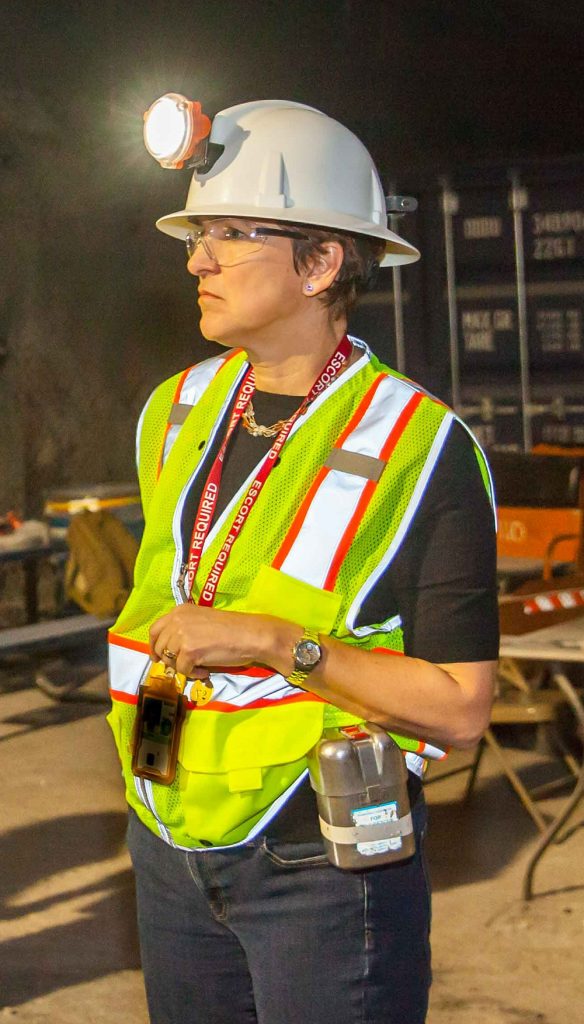Amy Halloran featured on DOE STEM Rising website

Amy Halloran became the director of nuclear fuel cycle and grid modernization for Sandia in 2021. Her team works in diverse areas of research, from ensuring the electric grid can handle renewable energy sources to enhancing the safety of nuclear energy to advancing the science of nuclear waste management. She was previously the senior manager for Sandia’s work in renewable energy and led research programs in wind energy, solar energy, water power, geothermal energy and the water and energy nexus.
Amy’s Sandia career started in 2011 when she was hired to be the manager of the Geophysics and Atmospheric Science Department. Her team worked in the areas of nuclear threat detection, climate measurement and oil and gas extraction. She also oversaw Sandia’s work on the North Slope of Alaska for DOE’s climate program. Prior to her work at the Labs, Amy worked as an environmental engineer in the areas of contaminated soil and groundwater investigation and remediation, industrial waste treatment and energy efficiency. Amy has a bachelor’s degree in chemical engineering from Virginia Tech and a master’s degree in environmental engineering from the University of Illinois.
Amy recently answered questions for the Women @ Energy blog.
What inspired you to work in science, technology, engineering and math?
Like most folks who go into STEM, it probably started with being good in math and science. I am also a problem solver — I love puzzles and games and putting together IKEA furniture — so engineering seemed to be a great place to develop my problem-solving skills and apply them to real world problems. No one in my family was an engineer, so it was kind of an unknown for me, but my parents were always very supportive of me going into STEM. I had a very inspiring 10th grade chemistry teacher, and she is probably the reason I ended up going into chemical engineering. I knew I wanted to make a positive difference in the work that I do, so I moved into environmental engineering to work in hazardous waste site investigation and cleanup — a fairly new field of research at the time.
What excites you about your work at the Labs?
I am very excited to be leading a team who is doing research and development that will help the nation meet the challenges of climate change. We need to have a safe, reliable energy system that moves us to a cleaner energy future. My team is doing impactful work in nuclear energy, energy storage and energy delivery. There are so many challenges that need to be overcome and the researchers I work with at Sandia and other national laboratories are helping to address those challenges.
At Sandia, we don’t make new nuclear reactors or batteries or waste disposal sites, but the research we do makes sure that they can all be deployed safely and that the grid will be ready to accept those and other distributed energy resources.
How can our country engage more women, girls and other underrepresented groups in STEM?
This is one I struggle with. I am so very proud that both my daughter and my son graduated with engineering degrees, and I like to think that I helped to inspire them on their STEM path. Somehow those of us in STEM fields need to make those personal connections and show young women and others from underrepresented groups that they can have a great, fulfilling career in STEM. Throughout my career I’ve done so many different things — I’ve never been bored. That’s one of the great things about working at Sandia and for DOE, you can apply your STEM skills to so many critical problems.
Do you have advice for someone looking to enter your field of work?
Be curious! Take the classes you need, like math and science, but also take other classes that you are interested in, even if you don’t see how you will use them. I got a minor in English and took classes in Russian history, biochemistry, meteorology, French and so many other disciplines, and I think those classes have helped me to bring a broader perspective to my work. If you’re in college, get to know your professors. Volunteer to help them with some of their projects so you can see applications of what you are learning and make it more real than the theory you are studying. That work will look great on a resume, and they can be valuable references.
Also, this may sound obvious, but proofread your resume and cover letter — we get so many applications for our job postings, and one way they get screened is by mistakes in the resume. If you don’t take the time to make your resume right, how can we expect you to do accurate work when you join our team?
When you have free time, what are your hobbies?
I love to ski, hike and camp and just be outdoors — Albuquerque and New Mexico offer so many opportunities for outside activities! I played soccer for decades and we go to all the home games for our local professional team. I’m a big reader and love to cook for my friends and family. And then, like so many others, we adopted a pandemic puppy, a standard poodle who just turned two, to join our other dog, a terrier, so my husband and I spend a lot of time on dog walks.